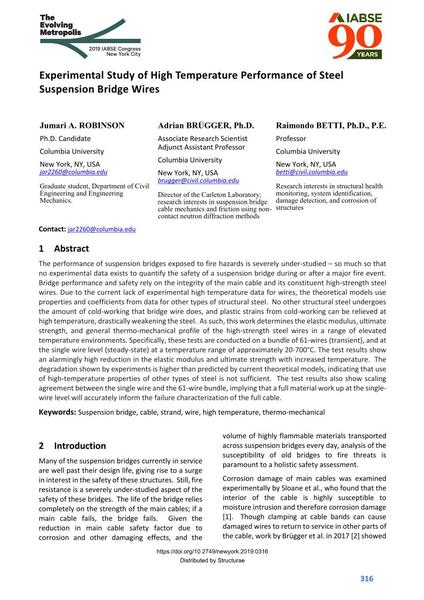Experimental Study of High Temperature Performance of Steel Suspension Bridge Wires

|
|
|||||||||||
Bibliografische Angaben
| Autor(en): |
Jumari A. Robinson
(Columbia University)
Adrian Brügger (Columbia University) Raimondo Betti (Columbia University) |
||||
|---|---|---|---|---|---|
| Medium: | Tagungsbeitrag | ||||
| Sprache(n): | Englisch | ||||
| Tagung: | IABSE Congress: The Evolving Metropolis, New York, NY, USA, 4-6 September 2019 | ||||
| Veröffentlicht in: | The Evolving Metropolis | ||||
|
|||||
| Seite(n): | 316-320 | ||||
| Anzahl der Seiten (im PDF): | 5 | ||||
| DOI: | 10.2749/newyork.2019.0316 | ||||
| Abstrakt: |
The performance of suspension bridges exposed to fire hazards is severely under-studied – so much so that no experimental data exists to quantify the safety of a suspension bridge during or after a major fire event. Bridge performance and safety rely on the integrity of the main cable and its constituent high-strength steel wires. Due to the current lack of experimental high temperature data for wires, the theoretical models use properties and coefficients from data for other types of structural steel. No other structural steel undergoes the amount of cold-working that bridge wire does, and plastic strains from cold-working can be relieved at high temperature, drastically weakening the steel. As such, this work determines the elastic modulus, ultimate strength, and general thermo-mechanical profile of the high-strength steel wires in a range of elevated temperature environments. Specifically, these tests are conducted on a bundle of 61-wires (transient), and at the single wire level (steady-state) at a temperature range of approximately 20-700°C. The test results show an alarmingly high reduction in the elastic modulus and ultimate strength with increased temperature. The degradation shown by experiments is higher than predicted by current theoretical models, indicating that use of high-temperature properties of other types of steel is not sufficient. The test results also show scaling agreement between the single wire and the 61-wire bundle, implying that a full material work up at the single- wire level will accurately inform the failure characterization of the full cable. |
||||
| Stichwörter: |
Hängebrücke Seil Litze Litze
|
||||
